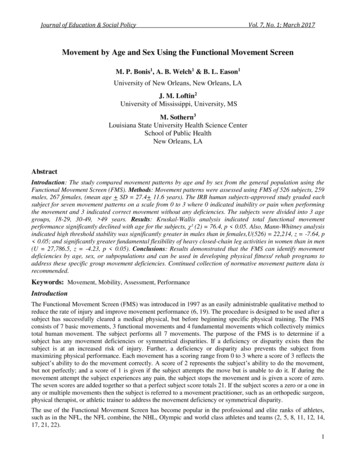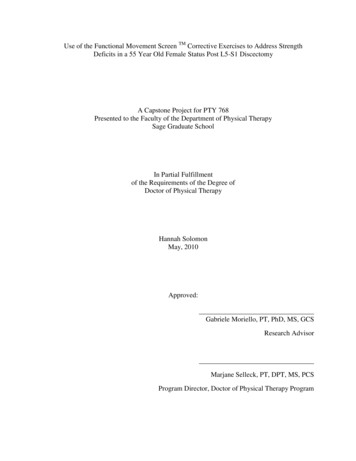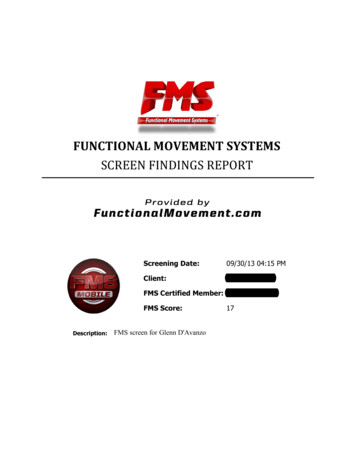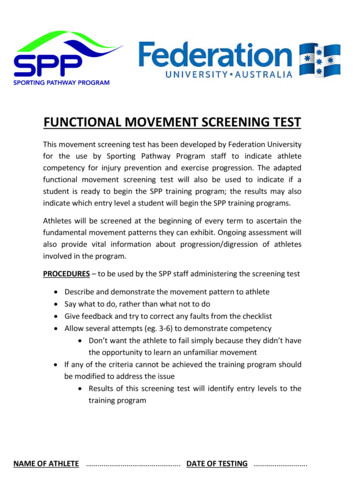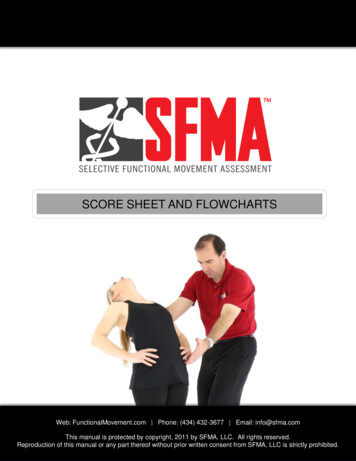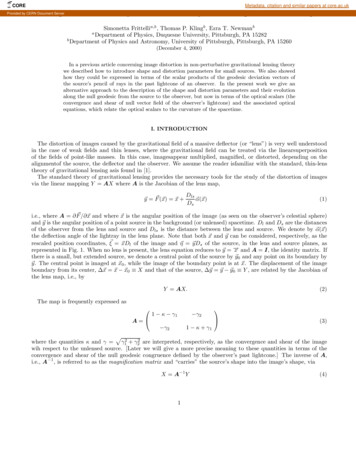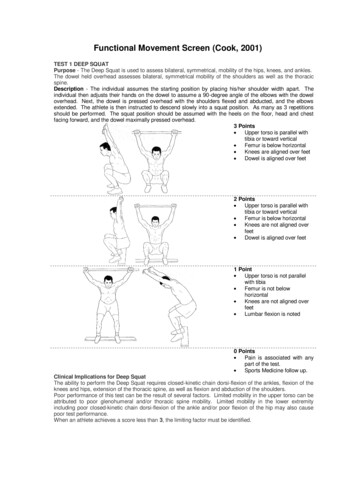
Transcription
Functional Movement Screen (Cook, 2001)TEST 1 DEEP SQUATPurpose - The Deep Squat is used to assess bilateral, symmetrical, mobility of the hips, knees, and ankles.The dowel held overhead assesses bilateral, symmetrical mobility of the shoulders as well as the thoracicspine.Description - The individual assumes the starting position by placing his/her shoulder width apart. Theindividual then adjusts their hands on the dowel to assume a 90-degree angle of the elbows with the doweloverhead. Next, the dowel is pressed overhead with the shoulders flexed and abducted, and the elbowsextended. The athlete is then instructed to descend slowly into a squat position. As many as 3 repetitionsshould be performed. The squat position should be assumed with the heels on the floor, head and chestfacing forward, and the dowel maximally pressed overhead.3 PointsUpper torso is parallel withtibia or toward verticalFemur is below horizontalKnees are aligned over feetDowel is aligned over feet2 PointsUpper torso is parallel withtibia or toward verticalFemur is below horizontalKnees are not aligned overfeetDowel is aligned over feet1 PointUpper torso is not parallelwith tibiaFemur is not belowhorizontalKnees are not aligned overfeetLumbar flexion is noted0 PointsPain is associated with anypart of the test.Sports Medicine follow up.Clinical Implications for Deep SquatThe ability to perform the Deep Squat requires closed-kinetic chain dorsi-flexion of the ankles, flexion of theknees and hips, extension of the thoracic spine, as well as flexion and abduction of the shoulders.Poor performance of this test can be the result of several factors. Limited mobility in the upper torso can beattributed to poor glenohumeral and/or thoracic spine mobility. Limited mobility in the lower extremityincluding poor closed-kinetic chain dorsi-flexion of the ankle and/or poor flexion of the hip may also causepoor test performance.When an athlete achieves a score less than 3, the limiting factor must be identified.
TEST 2 HURDLE STEPPurpose - The Hurdle Step is used to assess bilateral mobility and stability of the hips, knees, and ankles.Description - The individual assumes the starting position by placing his/her feet shoulder width apart. Thehurdle is then adjusted to the height of the athlete's tibial tuberosity. The dowel is positioned across theathlete's shoulders below their neck. The individual then aligns their toes directly beneath the hurdle. Theathlete is then asked to step over the hurdle and touch the heel while maintaining his/her stance leg in anextended position. Finally, the athlete is instructed to return to the starting position. The Hurdle Step shouldbe performed slowly and as many as 3 times bilaterally. If one repetition is completed bilaterally meeting thebelow criteria a 3 is given.3 PointsHips, knees and anklesremain aligned in the sagittalplane.Minimal to no movementnoted in lumbar spine.Dowel and hurdle remainparallel.2 PointsHip, knee and anklealignment lost.Movement noted in lumbarspine.Dowel and hurdle do notremain parallel.1 PointContact between foot andhurdle occurs.Loss of balance is noted.0 PointsPain is associated with anypart of the test.Sports Medicine follow up.Clinical Implications for Hurdle StepThe ability to perform the Hurdle Step test requires both stance leg stability of the ankle, knee, and hip aswell as maximal closed-kinetic chain extension of the hip. The Hurdle Step also requires leg open-kineticchain dorsi-flexion of the ankle and flexion of the knee and hip. The athlete must also display adequatesingle leg stance balance during this test.Poor performance of this test can be the result of several factors. It may simply be due to poor stability of thestance leg or poor mobility of the step leg. However, imposing maximal hip flexion of one leg whilemaintaining apparent hip extension of the opposite leg requires the athlete to demonstrate relative,asymmetric hip mobility.When an athlete achieves a score less than 3, the limiting factor must be identified.
TEST 3 IN-LINE LUNGEPurpose - The In-Line Lunge is used to assess bilateral mobility and stability, as well as ankle and kneestability.Description - The tester measures the individual's tibial length with a tape measure. The athlete then placesone foot on the end of the 2” x 6” board. The athlete places the dowel behind their back touching the head,thoracic spine, and sacrum. The hand ipsi-lateral to the back foot should be the hand grasping the top of thedowel; the contra-lateral hand grasps the bottom. The tester then measures the tibial length from the end ofthe individual's toes and a mark is made on the board. The athlete is then asked to take a step and placetheir heel on the mark. The athlete then lowers their back knee enough to touch the board behind the frontfoot. The feet should be on the same line and pointing straight throughout the movement. The lunge isperformed up to three times bilaterally in a slow controlled fashion. If one repetition is completedsuccessfully then a three is given.3 PointsMinimal to no torsomovement is noted.Feet remain parallel insagittal plane on board.Knee touches board behindheel of front foot.2 PointsTorso movement is noted.Feet do not remain parallelin sagittal plane.Knee does not touch boardbehind heel of front foot.1 PointLoss of balance is noted.0 PointsPain is associated with anypart of the test.Sports Medicine follow up.Clinical Implications for In-Line LungeThe ability to perform the In-Line Lunge test requires stance leg stability of the ankle, knee, and hip as wellas closed-kinetic chain hip abduction. The In-Line Lunge also requires step leg mobility of the hip adductionand ankle dorsi-flexion. The athlete must also display adequate balance during this test.Poor performance of this test can be the result of several factors. First of which is inadequate hip mobility ofeither the stance or step leg. Secondly, the stance leg knee or ankle may not have the required stability asthe lunge is performed. Thirdly, an imbalance may be present between adductor weakness and abductortightness about one or more hips. Finally, tightness of the rectus femoris on the stance leg may be thecause for poor performance.When an athlete achieves a score less than 3, the limiting factor must be identified.
TEST 4 SHOULDER MOBILITYPurpose - The Shoulder Mobility test is used to assess bilateral shoulder range of motion combining internalrotation with adduction and external rotation with abduction.Description - The tester first determines the athlete's hand length by measuring the distance from the distalwrist crease to the tip of the third digit. The athlete is instructed to make a fist with each hand, placing thethumb inside the fist. They are then asked to assume a maximally adducted and internally rotated positionwith one shoulder, and a maximally abducted and externally rotated position with the other. During the testthe hands should remain in a fist and they should be placed on the back in one smooth motion. The testerthen measures the distance between the two fists. Perform the Shoulder Mobility test as many as 3 timesbilaterally.3 PointsFists are within one handlength.2 PointsFists are within one and ahalf hand lengths.1 PointFists are not within one anda half hand lengths.* A shoulder stability screen should be performed even ifthe athlete scores a 3. The athlete places his/her hand onthe opposite shoulder and then attempts to point theelbow upward. If there is pain associated with thismovement, a score of 0 is given. It is recommended thata thorough evaluation of the shoulder be done. Thisscreen should be performed bilaterally. If the athletedoes receive a score of 0 both scores should bedocumented for future reference.Clinical Implications for Shoulder MobilityThe ability to perform the Shoulder Mobility test requires shoulder mobility in a combination of motionsincluding abduction/external rotation and adduction/internal rotation.Poor performance of this test can be the result of several factors. One of which is the widely accepted factorthat increased external rotation is gained at the expense of internal rotation in overhead throwing athletes.There can also be postural changes of forward or rounded shoulders caused by excessive development andshortening of the pectoralis minor and/or latissimus dorsi muscles. Finally a scapulothoracic dysfunctionmay be present resulting in decreased glenohumeral mobility.When an athlete achieves a score less than 3, the limiting factor must be identified.
TEST 5 ACTIVE STRAIGHT LEG RAISEPurpose - The Active Straight Leg Raise test is used to assess active hamstring and gastroc/soleusflexibility, while maintaining a stable pelvis.Description - The individual first assumes the starting position by lying supine with his/her arms at theirsides, palms up and head flat on the floor. The 2” x 6” is placed under the knees of the athlete. The testerthen identifies the athlete's anterior superior iliac spine (ASIS) and mid-point of the patella. Next, the athleteis instructed to lift the test leg with a dorsi-flexed ankle and an extended knee. During the test the oppositeknee should remain in contact with the 2” x 6” and head should remain flat on the floor. Once the athlete hasachieved their end range position, a dowel is aligned along the medial malleolus of the test leg,perpendicular to the floor. The Active Straight Leg Raise test should be performed as many as 3 timesbilaterally.3 PointsDowel resides between midthigh and ASIS.2 PointsDowel resides between midthigh and the joint line.1 PointDowel resides below thejoint line.0 PointsPain is associated with anypart of the test.Sports Medicine follow up.Clinical Implications for Active Straight Leg RaiseThe ability to perform the Active Straight Leg Raise test requires functional hamstring flexibility. Thisflexibility is the true flexibility an athlete has available during training and competition, as opposed to passiveflexibility, which is most often assessed. The athlete is also required to demonstrate adequate passiveiliopsoas flexibility of the opposite leg as well as lower abdominal stability.Poor performance during this test can be the result of several factors. First, the athlete may have poorfunctional hamstring flexibility. Secondly, inadequate passive mobility of the opposite hip may be the resultof iliopsoas tightness associated with an anterior tilted pelvis. If this limitation is gross, true active hamstringflexibility will not be realized. A combination of both these factors will demonstrate an athlete's relativebilateral, asymmetric hip mobility. This is similar to the relative hip mobility revealed by the Hurdle Step,however, this test is more specific to the limitations imposed by the muscles of the hamstrings and theiliopsoas.When an athlete achieves a score less than 3, the limiting factor must be identified.
TEST 6 TRUNK STABILITY PUSH-UPPurpose - The Trunk Stability Push-Up is used to assess trunk stability in the sagittal plane while asymmetrical upper extremity motion is performed.Description - The individual assumes a prone position. The hands are then placed shoulder width apart atthe appropriate position per the below criteria, knees fully extended. The individual is asked to perform onepush-up in this position. The body should be lifted as a unit; there should be no "lag" in the lumbar spinewhen performing this push-up. If the individual cannot perform a push-up in this position, the hands arelowered to the appropriate position per the below criteria, and a push-up is performed. The Trunk StabilityPush-Up can be performed as many as 3 times.3 PointsMales perform one repetitionwith thumbs aligned with topof head.Females perform onerepetition with thumbsaligned with the chin.2 PointsMales perform one repetitionwith thumbs aligned with topof head.Females perform onerepetition with thumbsaligned with the chin.1 PointMales are unable to performone repetition in modifiedposition.Females are unable toperform one repetition inmodified position.* Lumbar extension should also be cleared after thistest, even if a score of 3 is given. Spinal extensioncan be cleared by performing a press-up in the pushup position. If there is pain associated with thismotion, a 0 is given and a more thorough evaluationshould be performed0 PointsPain is associated with anypart of the test.Sports Medicine follow up.Clinical Implications for Trunk Stability Push-UpThe ability to perform the Trunk Stability Push-up requires symmetric trunk stability in the sagittal planeduring a symmetric upper extremity movement. Many functional activities in sport require the trunkstabilizers to transfer force symmetrically from the upper extremities to the lower extremities and vice versa.Movements such as rebounding in basketball, overhead blocking in volleyball, or pass blocking in football arecommon examples of this type of energy transfer. If the trunk does not have adequate stability during theseactivities, kinetic energy will be dispersed, leading to poor functional performance as well as increasedpotential for micro-traumatic injury.Poor performance during this test can be simply attributed to poor symmetric stability of the trunk stabilizers.When an athlete achieves a score less than 3, the limiting factor must be identified.
TEST 7 ROTATIONAL STABILITYPurpose - The Rotational Stability test is used to assess multi-planar stability while a combined upper andlower extremity motion is performed.Description - The individual assumes the starting position in quadruped with their shoulders and hips at 90degrees relative to the upper torso. The knees are positioned at 90 degrees and the ankles should remaindorsi-flexed. The 2” x 6” is the placed between the knees and hands so they are in contact with the board.The individual then flexes the shoulder and extends the same side hip and knee. The leg and hand are onlyraised enough to clear the floor by approximat
Functional Movement Screen (Cook, 2001) TEST 1 DEEP SQUAT Purpose - The Deep Squat is used to assess bilateral, symmetrical, mobility of the hips, knees, and ankles. The dowel held overhead assesses bilateral, symmetrical mobility of the shoulders as well as the thoracic spine. Description - The individual assumes the starting position by placing his/her shoulder width apart. The individual .
